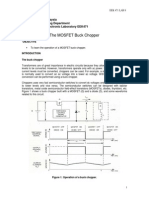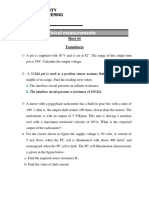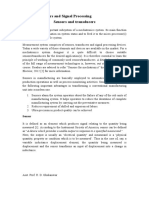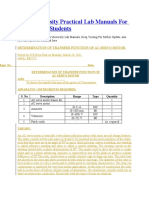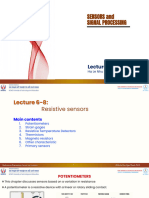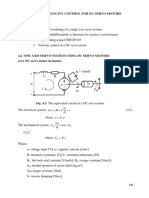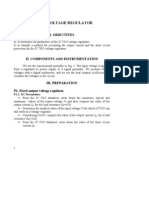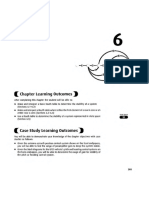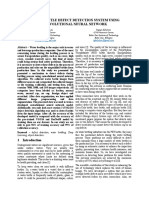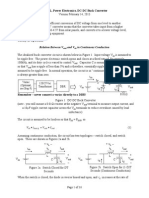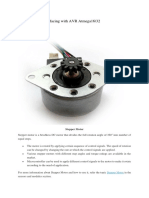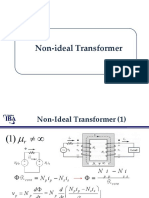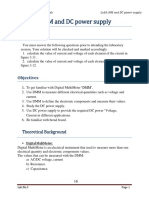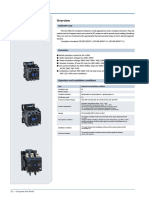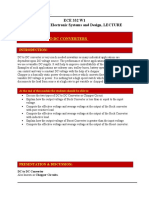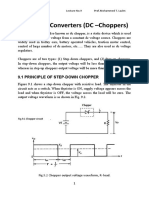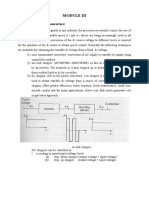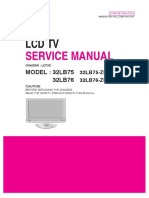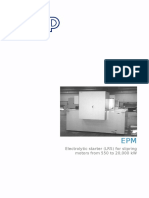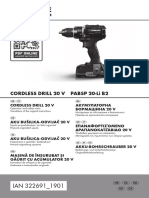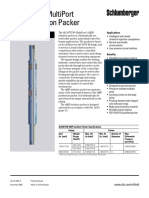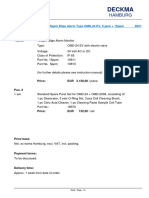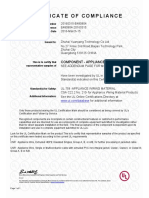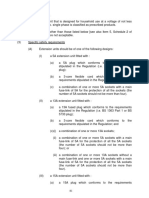Power Electronics
DC-DC Converters (DC –Choppers)
A dc‐to‐dc converter, also known as dc chopper, is a static device which
is used to obtain a variable dc voltage from a constant dc voltage
source. Choppers are widely used in trolley cars, battery operated
vehicles, traction motor control, control of large number of dc motors,
etc….. They are also used as dc voltage regulators.
Choppers are of two types: (1) Step‐down choppers, and (2) Step‐up
choppers. In step‐down choppers, the output voltage will be less than
the input voltage, whereas in step‐up choppers output voltage will be
more than the input voltage.
PRINCIPLE OF STEP‐DOWN CHOPPER
Figure 1 shows a step‐down chopper with resistive load. The thyristorin
the circuit acts as a switch. When thyristor is ON, supply voltage appears
across the load and when thyristor is OFF, the voltage across the load
will be zero. The output voltage waveform is as shown in Fig. 2.
Fig.1 Chopper circuit.
Fig.2 Chopper output voltage waveform, R- load.
1
�Power Electronics
Methods of Control
The output dc voltage can be varied by the following methods.
Pulse width modulation control or constant frequency operation.
Variable frequency control.
Pulse Width Modulation
tON is varied keeping chopping frequency ‘f’ & chopping period ‘T’
constant.
Output voltage is varied by varying the ON time tON
ANALYSIS OF A STEP‐DOWN CHOPPER WITH R-
LOAD
Referring to Fig.2, the average output voltage 𝑣𝑜 can be found as
Let T= control period = ton + toff
1 𝑡
𝑣𝑜 = 𝑉𝑎𝑣 = ∫ 𝑜𝑛 𝑉𝑑 𝑑𝑡
𝑇 0
𝑉𝑜 = 𝑉𝑑 𝑡𝑜𝑛 = 𝑉𝑑(𝛾)
𝑇
𝑤ℎ𝑒𝑟𝑒 , 𝛾 = 𝑡𝑜𝑛 = 𝐷𝑢𝑡𝑦 𝑐𝑦𝑐𝑙𝑒
𝑇
Maximum value of γ =1 when ton =T (toff= 0)
Minimum value of γ = 0 when ton = 0 (toff = 0)
The output voltage is stepped down by the factor γ
(0 ≤ Vo ≤ Vd ) .Therefore this form of chopper is a step down chopper.
1 ton 2
The R.M.S. value of the output voltage o,rms 0 v0 dt vd
v
T
2 2
vo,rms v
The Output power = d
R R
2
� Power Electronics
P v 2
1 v
Input current (Assume 100% efficiency) I a d
d
V R vd R
1
f= chopping frequency = ( ) = 1/ T
chopping period (T )
The ripple factor, RF
It is a measure of the ripple content.
Vorms 2 Vd 2 1 1
RF ( ) 1 ( 2 2 ) 1 1
Vo Vd
Note1: In this type of chopper both the voltage and current are
always positive, hence this chopper is called a single-quadrant Buck
converter or class – A chopper.
Fig.3 Single – quadrant operation
Note2: The chopper switch can also be implemented by using a
power BJT, power MOSFET, GTO, and IGBT transistor. The practical
devices have a finite voltage drop ranging from 0.5V to 2V, and for
the sake of simplicity, the voltage drop of their power semi-
conductor devices are neglected.
3
�Power Electronics
Example 1: A transistor dc chopper circuit (Buck converter) is
supplied with power form an ideal battery of 100 V. The load voltage
waveform consists of rectangular pulses of duration 1 ms in an
overall cycle time of 2.5 ms. Calculate, for resistive load of 10 Ω.
(a) The duty cycle γ.
(b) The average value of the output voltage Vo.
(c) The rms value of the output voltage Vorms.
(d) The ripple factor RF.
(e) The output dc power.
Solution:
(a) ton = 1ms , T=2.5 ms
𝑡𝑜𝑛 1 𝑚𝑠 = 0.4
𝛾= =
𝑇 2.5 𝑚𝑠
(b) Vav =Vo = γ Vd = 0.4 x 100 = 40 V.
(c ) 𝑉𝑜𝑟𝑚𝑠 = √𝛾 𝑉i = √0.4 x100 = 63.2 V.
1 1 0.4
(d) RF 1.225
0.4
(e) 𝐼𝑎 = 𝑉𝑜 = 40 = 4𝐴
𝑅 10
Pav = Ia Vo = 4x40 = 160 W
4
�Power Electronics
STEP‐DOWN CHOPPER WITH R‐L LOAD
Consider a class-A chopper circuit with R-L load as shown in
Fig.4.This is a step down chopper with one quadrant operation.
If we use the simplified linear analysis by considering that T<< τ, where
(T = ton + toff ) . In this case the current is continuous as shown in Fig.5.
Fig.4
Fig.5
5
�Power Electronics
Referring to Fig.5:
The current variation is almost linear and the current waveform
becomes triangular.
During the ON period , the equation govern the circuit is
𝑑i
𝑉𝑑 = 𝑅i + 𝐿
𝑑𝑡
𝑑i
Since 𝑑𝑡 = constant, hence during ON period:
𝑑i 𝐼2 − 𝐼1 ∆𝐼
= =
𝑑𝑡 𝑡𝑜𝑛 𝑡𝑜𝑛
Where ΔI is the peak – to –peak of the load current .Thus the equation
of the current is given by:
∆I
i =𝐼 + 𝑡 0≤𝑡≤𝑡
1 1 𝑜𝑛
𝛾𝑇
Where 𝛾= 𝑡𝑜𝑛
𝑇
During the off period:
𝑑i 𝐼1 − 𝐼2 ∆
𝐼 ΔI ΔI ΔI
= =− =− =− =−
𝑑𝑡 𝑡𝑜ƒƒ 𝑡𝑜ƒƒ 𝑇 − 𝑡𝑜𝑛 𝑇 − 𝛾𝑇 (1 − 𝛾)𝑇
Hence, during the off the equation of the current is
ΔI
i2 = 𝐼 2 − (𝑡 − 𝑡𝑜𝑛 ) 𝑡𝑜𝑛 ≤ 𝑡 ≤ 𝑇
(1 − 𝛾)𝑇
The average value of the output current is
1
𝐼 1[ 1 𝑡 (𝐼 − 𝐼 ) + 𝑡 (𝐼 − 𝐼 ) + 𝐼 𝑇]
𝑎𝑣 =
𝑇 2 𝑜𝑛 2 1
2 𝑜ƒƒ 2 1 1
𝐼𝑎𝑣 = 1 (𝐼2 + 𝐼1)
2
6
�Power Electronics
Example 2; An 80 V battery supplies RL load through a DC chopper.
The load has a freewheeling diode across it is composed of 0.4 H in
series with 5Ω resistor. Load current, due to improper selection of
frequency of chopping, varies widely between 9A and 10.2.
(a) Find the average load voltage, current and the duty cycle of the
chopper.
(b) What is the operating frequency f ?
(c) Find the ripple current to maximum current ratio.
Solution:
(a) The average load voltage and current are:
Vav = Vo = γ Vd
𝐼𝑎𝑣 = 1 (𝐼2 + 𝐼1) = 9+10.2 = 9.6𝐴
2 2
𝑉𝑎𝑣 𝛾𝑉𝑑 𝑜𝑟 𝛾= 𝐼𝑎𝑣 𝑅 = 9.6 𝑥 5 = 0.6
𝐼𝑎𝑣 = =
𝑅 𝑅 𝑉i 80
Vav = 0.6 x 80 = 48 V.
(b) To find the operating (chopping) frequency:
During the ON period,
𝑉𝑑 = 𝑅i + 𝐿 𝑑i … … … … … . (1)
𝑑𝑡
Assuming 𝑑i ≅ 𝑐𝑜𝑛𝑠𝑡𝑎𝑛𝑡
𝑑𝑡
𝑑i ∆
𝐼 10.2 − 9 1.2
≅ = =
𝑑𝑡 𝑡𝑜𝑛 𝛾𝑇 𝛾𝑇
𝑑i
From eq.(1) 𝐿 𝑑𝑡 ≅ 𝑉𝑑 − 𝐼𝑎𝑣 𝑅 = 80 − 5𝑥9.6 = 32𝑉
𝑑i 32
or = = 32 = 80 𝐴. 𝑠
𝑑𝑡 𝐿 0.4
7
�Power Electronics
𝑑i 1.2
but = 1.2 = 80 =
𝑑𝑡 𝛾𝑇 0.6 𝑇
1.2
∴ 𝑇= = 25 𝑚𝑠
0.6𝑥80
Hence ƒ= 1 = 1 = 40 𝐻𝑧
𝑇 25𝑥10 −3
The maximum current Im occurs at γ = 1,
∴ 𝐼𝑚 = 𝛾𝑉𝑑 = 1𝑥80 = 16𝐴
5
𝑅
Ripple current Ir = ΔI = 10.2- 9 =1.2 A
𝐼r
∴ = 1.2 = 0.075 𝑜𝑟 7.5% .
𝐼𝑚 16
Input Current Is
For the class-A chopper had shown in Fig.4, the On-state and OFF- state
equivalent circuits are as depicted in Fig.6. When the thyristor is closed
(during the ON period), the load current “i” rises from I1 to I2 and falls
from I2 to I1 during the off period as shown in Fig.7(a).The input current is
flows during the ON period only as shown in Fig .7(b).
ON- State Equivalent CCT OFF – State Equivalent CCT
Fig.6
8
�Power Electronics
(a)
(b)
Fig.7
The equation of the input current is
∆I
i = i =𝐼 + 𝑡 0≤𝑡 ≤𝑡
𝑠 1 𝑜𝑛
1 𝛾𝑇
i𝑠 = 0 𝑡𝑜𝑛 ≤ 𝑡 ≤ 𝑇
The average value of the current drawn from the supply is simply
found by,
𝐼 1[1 𝑡 (𝐼 − 𝐼 𝑡𝑜𝑛𝐼1
𝑠(𝑎𝑣) =
)] +
𝑇 2 𝑜𝑛 2 1
𝑇
𝑡𝑜𝑛
𝐼 1[1 𝑡 (𝐼 + 𝐼 )] = (𝐼 + 𝐼 ) = 𝛾𝐼
=
𝑠(𝑎𝑣)
𝑇 2 𝑜𝑛 2 1
2𝑇 2 1 𝑎𝑣
9
�Power Electronics
Minimum and Maximum Load Currents
The minimum current I1 and maximum current I2 can be found from the
following two equations:
𝐼 =𝐼 𝑉𝑜 𝑡𝑜ƒƒ
1 𝑚i𝑛
= − 𝑉
𝑅 2𝐿 𝑜
𝐼 =𝐼 𝑉𝑜 𝑡𝑜ƒƒ
2 𝑚𝑎𝑥 = + 𝑉
𝑅 2𝐿 𝑜
Where Vo = Vav
Note: The proof of these two equations is not needed
Example 3: A DC Buck converter operates at frequency of 1 kHz from
100V DC source supplying a 10 Ω resistive load. The inductive
component of the load is 50mH.For output average voltage of 50V volts,
find:
(a) The duty cycle
(b) ton
(c) The rms value of the output current
(d) The average value of the output current
(e) Imax and Imin
(f) The input power
(g) The peak-to-peak ripple current.
10
�Power Electronics
Solution:
(a) Vav =Vo = γ Vd
𝑉𝑎𝑣 50 = 0.5
𝛾= =
𝑉𝑑 100
(b) T= 1/ f = 1 / 1000 = 1ms
𝑡𝑜𝑛
𝛾=
𝑇
ton = γ T = 05 x1ms= 0.5 ms .
(c ) 𝑉𝑜𝑟𝑚𝑠 = √𝛾 𝑉i =√0.5 𝑥 100 = 70.07 𝑉
𝑉𝑎𝑣
(d) 𝐼𝑎𝑣 = = 50 =5𝐴
𝑅 10
(e) 𝐼 𝑉𝑎𝑣 𝑡𝑜ƒƒ 50 (1−0.5)𝑥10−3
𝑚𝑎𝑥
= + 𝑉𝑎𝑣 = + 𝑥50
𝑅 2𝐿 10 2𝑥50𝑥10−3
= 5 + 0.25 = 5,25 A
𝑉𝑎𝑣 𝑡𝑜ƒƒ 50 (1−0.5)𝑥10−3
𝐼𝑚i𝑛 = − 𝑉𝑎𝑣 = − 𝑥50
𝑅 2𝐿 10 2𝑥50𝑥10−3
= 5 - 0.25 = 4.75 A
(f)
𝛾
𝐼𝑠(𝑎𝑣) = (𝐼 + 𝐼𝑚𝑎𝑥 ) = 𝛾𝐼𝑎𝑣 = 0.5 𝑥5 = 2.5𝐴
2 𝑚i𝑛
𝑃i𝑛 = 𝐼𝑠(𝑎𝑣)𝑉𝑑 = 2.5 𝑥100 = 250 W
(g) 𝐼 − = ∆𝐼 = 𝐼𝑚𝑎𝑥 − 𝐼𝑚i𝑛 = 5.25 − 4.75 = 0.5𝐴
11
�Power Electronics
12
